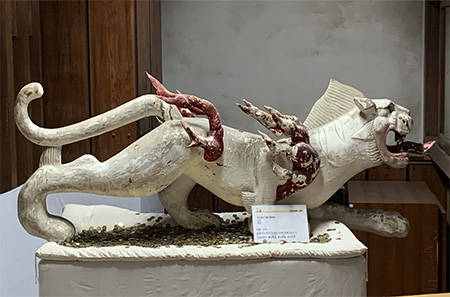


<和歌山城は「虎伏山」の自然地形を活用したもの。その由来を示す置物>
現代は人の集散機能性・交流優先の街づくりが行われている。
江戸末期人口が3,000万人社会から戦前期に6,000万人まで人口増加。
そして戦後から今日までで人口1億2,000万人まで増加し、
それは大都市圏の人口吸引によって達成されてきた。
これだけの社会激変があって高層コンクリートによって街が建築されている。
交通網も飛躍的に高度化してきているけれど、
戦国末期から江戸期への激変ぶりも凄かったのではないだろうか。
現代の「大都市」は札幌以外、その多くは言うまでもなく
この時期に「都市創造計画」の起点が記されている。
藤堂高虎という人物は徳川家康への擦り寄りぶりから
上方社会の嫌われ者みたいな評価が多いけれど、
こと城郭建築という面では各地にその事業痕跡を残している。
この時代の城とは軍事目的が基本だけれど同時に「まちづくり」でもある。
信長の楽市楽座や安土城がひとつの時代的転機を形成したのだろうけれど
世界情勢としての「大航海時代」に日本社会が遭遇して
資本主義的、重商主義的視点からの社会改造が活況を呈していた。
政治軍事経済が一体になって「まちづくり」の骨格形成がされた。
かれ藤堂高虎はこういう時代にあって城郭建築の第一人者と呼ばれた。
その基礎は豊臣秀長に仕えていた時代に形成され、
<秀長の勧めで当代一流の棟梁、中井正清・甲良宗広・穴太衆ら建築者と交流。
また織田信長の安土城築城では秀吉も築城奉行の一人であったので、
当然高虎も秀長に従って工事に従事している。
和歌山城の築城に当たって普請奉行に任命され初の築城差配を経験。
方広寺大仏殿建設の際には材木を熊野から調達するよう秀吉から命じられる。
聚楽第内の徳川屋敷建築に携わる。高虎は渡された設計図に難点があると
独断で設計変更、費用は自分の持ち出しとする。のちに家康に引見され、
設計図と違う点を尋ねられると「家康様に御不慮があれば主人・秀長の不行き届き、
関白秀吉様の面目に関わると存じ私の一存で変更しました。御不興であれば
ご容赦なくお手討ちを」と返した。家康は高虎の心遣いに感謝したという。>
というような経歴がWikiに記載されている。
かれはどうも建築土木の総合された築城行為に「数寄」を感じていたに違いない。
中井正清・甲良宗広・穴太衆という現代で言えば鹿島建設・竹中工務店といった
大手エネコンに比較しうるような存在と深く関わっていたのだろう。
かれらを建築施工者として使いながら、多数の「城」建設に取り組んだ。
こういう特殊技能者、建築家であり同時に政治家・軍人とも思える人物に対し
家康はその能力を存分に引き出したのだというようにも思える。
武将であり、戦場での武者働きに秀でていたことは前提ではあるけれど、
安部龍太郎氏の小説を読むと、秀長からはそういう武者根性をたしなめられ
より高い視点で世に尽くすことを考えよ、と諭されたとされる。
和歌山城の縄張りの基幹に建築者の「数寄」の痕跡を見る思いがします。
English version⬇
Exploration of Nara and Wakayama during the booming period of castle “construction” from the end of the Warring States period-26
Japan’s major cities originated in urban design from the perspective of military politics and economy during the Sengoku and Edo periods. This exhibition hand-dug the “age of architecture”. Nara and Wakayama
Today, the city is being developed with priority given to the functionality of gathering and dispersing people and interaction.
The population grew from 30 million at the end of the Edo period to 60 million in the prewar period.
The population has increased to 120 million since the end of World War II.
This has been achieved by attracting the population of large metropolitan areas.
With such a drastic social change, cities are being built with high-rise concrete.
The transportation network has also become dramatically more sophisticated.
The drastic changes from the end of the Warring States period to the Edo period must have been tremendous as well.
Needless to say, most of today’s “big cities” except for Sapporo were built during this period.
The starting point of the “City Creation Plan” was written during this period.
Takatora Todo was a man who was known to be a hated figure in the upper class society because of his close relationship with Ieyasu Tokugawa.
Takatora Todo is often regarded as a hated figure in the upper classes of society because of his close ties to Ieyasu Tokugawa.
However, in terms of castle construction, he has left traces of his business in many places.
Castles of this period were basically for military purposes, but at the same time, they also served the purpose of “community building.
Nobunaga’s Rakuichi Rakuza and Azuchi Castle may have marked a turning point in the history of castles.
However, the “Age of Discovery” that Japanese society encountered as a global situation
The social transformation from a capitalist and mercantilist viewpoint was booming.
Political, military, and economic activities were integrated to form the framework of “urban development.
Takatora Todo was called the leading expert on castle construction in this era.
The foundation was formed during his time in the service of Toyotomi Hidenaga.
<At Hidenaga’s urging, he interacted with the leading master builders of the day, including Masakiyo Nakai, Munehiro Koura, and Ano-shu.
In addition, since Hideyoshi was one of the magistrates in charge of the construction of Azuchi Castle by Oda Nobunaga, Takatora naturally followed Hidenaga’s lead in the construction of the castle.
Naturally, Takatora also followed Hidenaga’s lead and worked on the construction.
In the construction of Wakayama Castle, Takatora was appointed as a fukushin-bugyo and experienced his first experience in castle construction.
When constructing the Great Buddha Hall of Hokoji Temple, he was ordered by Hideyoshi to procure lumber from Kumano.
Takatora was involved in the construction of Tokugawa Ieyasu’s residence in Jurakudai. When Takatora found a security problem in the blueprints he was given, he changed the design at his own discretion.
Takatora changed the design at his own discretion and decided to pay for it out of his own pocket. Later, Ieyasu took a look at the plans and asked him what was different from the blueprints.
Ieyasu later visited Takatora and when asked about the differences from the blueprints, Takatora replied, “If Ieyasu-sama is not pleased, it is because his master, Hidemasa, has been careless.
I made the change on my own initiative because I knew it would affect the honor of Hideyoshi Kanpaku. If you are displeased
If you are displeased, please strike him down without mercy. Ieyasu is said to have thanked Takatora for his thoughtfulness. >Ieyasu is said to have thanked Takatora for his thoughtfulness.
Ieyasu is said to have thanked Takatora for his thoughtfulness.
He must have felt “sukiyoshi” in the integrated act of building a castle with architecture and civil engineering.
The company’s name is a reference to Masakiyo Nakai, Munehiro Koura, and Anodashu, who today can be compared to major energy contractors such as Kajima Corporation and Takenaka Corporation.
They must have been deeply involved with Masakiyo Nakai, Munehiro Koura, and Anata Shu, who today would be compared to major energy contractors such as Kajima Corporation and Takenaka Corporation.
He used them as builders in the construction of many “castles”.
Ieyasu fully exploited the abilities of these special technicians, architects, politicians, and military men.
Ieyasu may have drawn out their abilities to the fullest.
Although it is a given that Ieyasu was a military commander and excelled at warrior work on the battlefield, Ieyasu was not a warrior.
However, Ryutaro Abe’s novel suggests that Hidenaga was chastised by Ieyasu for his warrior spirit, and that Ieyasu was more interested in serving the world from a higher perspective.
However, according to Ryutaro Abe’s novel, Hidenaga was said to have rebuked such warrior spirit and admonished him to think about serving the world from a higher perspective.
I think I see traces of the architect’s “sukiyoshi” in the backbone of Wakayama Castle’s layout.
Posted on 5月 14th, 2022 by 三木 奎吾
Filed under: 住宅マーケティング, 歴史探訪







コメントを投稿
「※誹謗中傷や、悪意のある書き込み、営利目的などのコメントを防ぐために、投稿された全てのコメントは一時的に保留されますのでご了承ください。」
You must be logged in to post a comment.